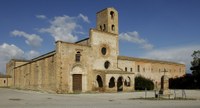Theme tours
The Abbeys
| Cartografia | |
|
Inserisci l'indirizzo di partenza e clicca sul pulsante Cerca
|
|
This itinerary will allow you to discover the roman Benedictine abbeys in the Vomano area, real “spiritual places” where you can unearth the charm and the tradition of this area’s popular faith.
From the wonderful art city of Atri, take the state road 150 towards Montorio al Vomano. Soon, after only a few kilometers, on the right, in the territory of Morro D’Oro, you reach the first destination of your trip: Santa Maria di Propezzano, an ancient abbey already existing perhaps in 715.
Romanesque and Gothic style seem to merge in this wonderful example of abruzzese medieval architecture and even though it’s been partially rebuilt over the years, today it still seems to maintain a typically Benedictine structure. The facade is built in three parts of different heights; the left one is part of the convent and the central body has a three arched portico under which there is a portal and the remains of frescoes from the 1400's. Above the portico there's a oculum and higher up there's a modest rose window. The right part has a portal called La Porta Santa that's opened only on the 10th of may and on the day of Ascension. Right behind the abbey there's a quadrangular bell tower.
The interior of the church is made up of three rows of arches and is home to the remains of frescoes from the 1400's. Inside the convent (which is not always visitable) is the quadrangular internal garden dating back to the 16th century, with a double row of arches and a well in the middle. In the archways of the internal garden there are what remains of the frescoes of the polish painter Sebastian Majewski and in the mess hall there are frescoes from the 1500's depicting the legend of it's foundation.
Proceeding along this path between “art and faith, a few kilometers from Propezzano you'll encounter San Clemente al Vomano, in the township of Guardiavomano, in the city of Notaresco. Only recently reopened to the public after a long period of restoration. The Abbey dates back to the 11th century. We wish to point out that the interior is made up of three rows of arches that bring you, through columns and pillars, to the presbiterium where there's a prized tabernacle of Norman make. The tabernacle, finely carved by Roberto di Ruggero in the 12th century, is the most ancient in Abruzzo.
From the State road SS 150 turn at the intersection that'll bring you to the picturesque hamlet of Canzano. Here, in the locality of Colle San Salvatore, you'll find the abbey of San Salvatore di Canzano (12th century). The Benedictine building of the abbey is of the Roman era but is for sure more ancient. Unfortunately the restoration process has altered radically all of the original structure. A few of the details in the facade such as the column tops with the symbols of the four evangelists on the portal and a “starred cross” built in above it seem to leave open the hypothesis of a Lombard hand in it's construction. The inside is made up of three rows of arches and ends with a large altar. The church's fame comes from the fact that it is home to many frescoes thus earning it the name of “Cappella Scrovegni”d'Abruzzo. Worthy of note are the 1300's paintings attributed to Maestro di Offida situated below the arches. They represent the Presentation at the Temple, The Last Supper, The Annunciation and the Cruxifiction.
Leave San Salvatore and continue on the SS 150 towards Isola del Gran Sasso. Nearby, on the left, you can see the profile of Santa Maria di Ronzano, by far the most beautiful example of Apulian Romanesque style in Abruzzo. Once part of a Benedictine monastery complex, it's presbiterium keeps wonderful paintings from the 1400's illuminated by the light that enters the church through the big round window in the churches facade.
Our journey ends at the foothills of the Gran Sasso. Here, near the village of Isola del Gran Sasso, you'll find San Giovanni ad Insulam(also known as San Giovanni del Mavone). Built probably around the 12th century, it's a good example of Romanesque-Gothic architecture in Abruzzo. The side walls of the portal appear decorated with lions and doves and also other fantastical animals such as dragons, typical of medieval mentality. Once you enter you are immediately stricken by the internal structure and the variety of the churche's shapes. The far wall of the church is adorned with a fresco of the 1400's depicting Christ in a almond tree between The Virgin Mary and Saint John the Baptist with Baby Jesus.


















